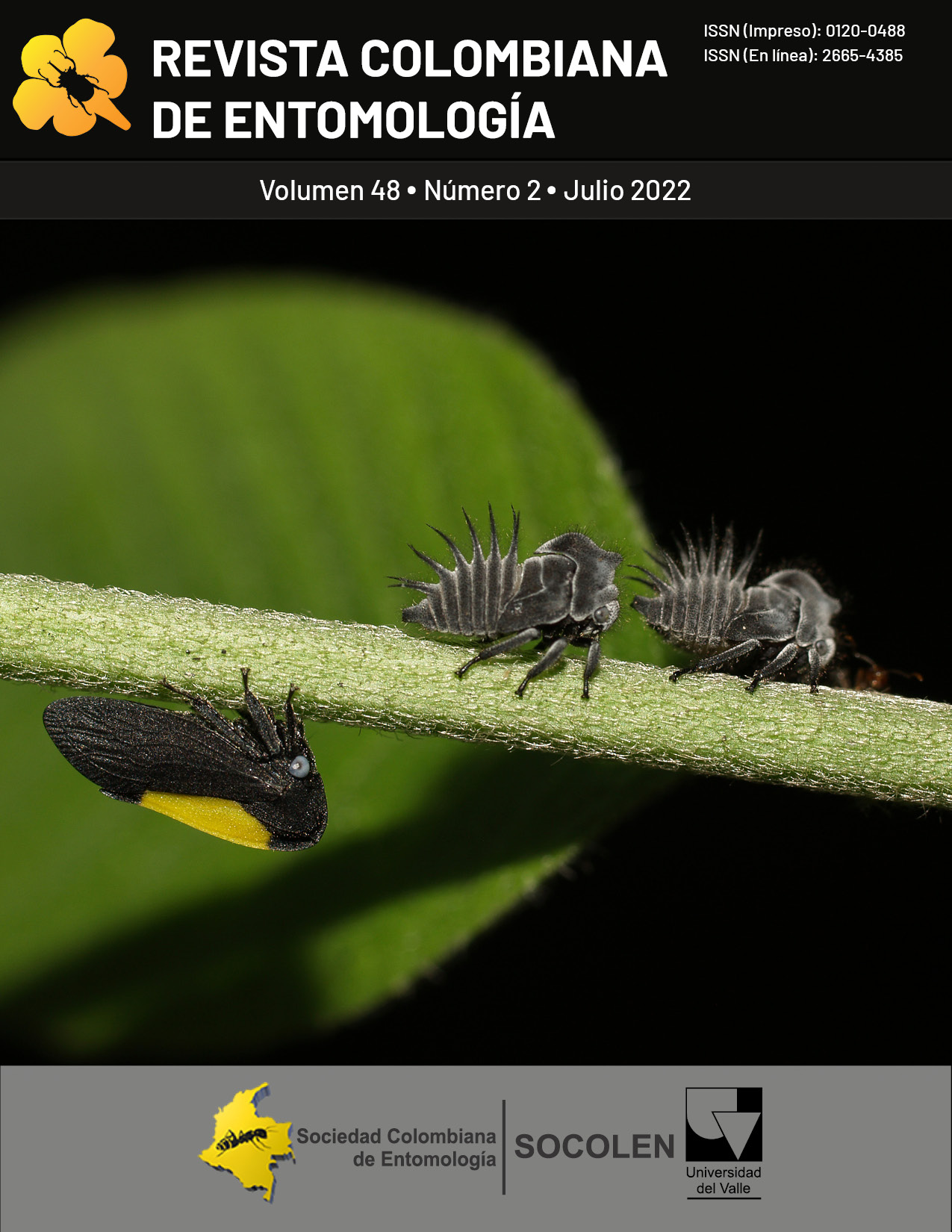First records of two species and two genera of ants (Hymenoptera: Formicidae) collected in a semi-urban area from Yucatan, Mexico
Keywords:
ants, descompotition, forensic entomologyMain Article Content
First records of two ant species, i.e., Hypoponera opacior and Pseudomyrmex seminole, and two genera, i.e., Acanthosticus, Mycetosoritis, associated with decaying stages of necrotramps established in a semi-urban area of Yucatan, Mexico.
ANDRADE-SILVA, J.; PEREIRA, E. K. C.; SILVA, O.; SANTOS, C. L. C.; DELABIE, J. H. C.; REBÊLO, J. M. M. 2015. Ants (Hymenoptera: Formicidae) associated with pig carcasses in an urban area. Sociobiology 62 (4): 527-532. http://periodicos.uefs.br/index.php/sociobiology/article/view/795
ANTWEB. 2021. AntWeb Versión 8.64.2. California Academy of Science, Disponible en: https://www.antweb.org. [Fecha: 30 de septiembre de 2021].
ANTWIKI. 2022. AntWiki. Disponible en. https://antwiki.org/wiki/Welcome_to_AntWiki. [Fecha: 4 de enero de 2022].
BOROWIEC, M. L. 2016. Generic revision of the ant subfamily Dorylinae (Hymenoptera, Formicidae) ZooKeys 608: 1-280. https://doi.org/10.3897/zookeys.608.9427
COOVERT, G. A. 2005. The ants of Ohio (Hymenoptera: Formicidae): an updated checklist. Bulletin of the Ohio Biological Survey 15:1-202. https://doi.org/10.3897/jhr.70.35207
CORONADO-BLANCO, J. M.; DUBOVIKOFF, D. A.; RUIZ-CANCINO, E.; VASQUEZ-BOLANOS, M.; FLORES-MALDONADO, K. Y.; HORTA-VEGA, J. V. 2013. Formicidae (Hymenoptera) del estado de Tamaulipas, México. CienciaUat 25 (1): 12-17.
https://doi.org/10.29059/cienciauat.v7i2.13
DÁTTILO, W.; VÁSQUEZ-BOLAÑOS, M.; AHUATZIN, D. A.; ANTONIAZZI, R.; CHÁVEZ-GONZÁLEZ, E.; CORRO, E.; LUNA, P.; GUEVARA, R.; VILLALOBOS, F.; MADRIGAL-CHAVERO, R.; et al. 2019. Mexico ants: incidence and abundance along the Nearctic-Neotropical interface. Ecology 101 (4): e02944. https://doi.org/10.1002/ecy.2944
DUBOIS, M. B. 1986. A revision of the native New World species of the ant genus Monomorium (minimum group) (Hymenoptera: Formicidae). University of Kansas Science Bulletin. 53: 65-119. https://www.biodiversitylibrary.org/page/2972544#page/75/mode/1up
ECONOMO, E.; GUÉNARD, B. 2021. AntMaps. Disponible en: https://antmaps.org/? [Fecha: 26 de septiembre de 2021].
FERNÁNDEZ, F. 2003. Introducción a las hormigas de la región Neotropical. Instituto de Investigación de Recursos Biológicos Alexander von Humboldt, Bogotá, Colombia, 398 p. http://repository.humboldt.org.co/handle/20.500.11761/32961
FERNÁNDEZ, F.; GUERRERO, R. J.; SÁNCHEZ-RESTREPO, A. F. 2021. Systematics and diversity of Neotropical ants. Revista Colombiana de Entomología 47 (1): e11082. https://doi.org/10.25100/socolen.v47i1.11082
FERNÁNDEZ, F.; PALACIO, E. E. 2006. Familia Formicidae. págs. 521-538. En: Fernández, F.; Sharkey, M. J. (Eds.). Introducción a los Hymenoptera de la Región Neotropical. Sociedad Colombiana de Entomología y Universidad Nacional de Colombia, Bogotá D. C. 894 p. https://repository.agrosavia.co/handle/20.500.12324/34432
FISHER, B. L.; COVER, S. P. 2007. Ants of North America. A guide to genera. Berkeley: University of California Press, 194 p. https://doi.org/10.1525/9780520934559
GUENARD, B.; WEISER, M. D.; GOMEZ, K.; NARULA, N.; ECONOMO, E. P. (2017). The Global Ant Biodiversity Informatics (GABI) database: synthesizing data on the geographic distribution of ant species (Hymenoptera: Formicidae). Myrmecological News/Osterreichische Gesellschaft fur Entomofaunistik 24, 83-89. https://doi.org/10.25849/myrmecol.news_024:083
HASHMI, A. A. 1973. A revision of the Neotropical ant subgenus Myrmothrix of genus Camponotus (Hymenoptera: Formicidae). Studia Entomologica 16 (1-4): 1-140. https://doi.org/10.5281/zenodo.26216
HÖLLDOBLER, B.; WILSON, E. O. 1990. The ants. Harvard University Press, USA, 743 p. https://www.hup.harvard.edu/catalog.php?isbn=9780674040755
MACKAY, W.; MACKAY, E. 1989. Clave de los géneros de hormigas en México (Hymenoptera: Formicidae). Segundo Simposio Nacional de Insectos Sociales. 36 p.
https://www.researchgate.net/publication/255645332
MACKAY, W.P. 1996. A revision of the ant genus Acanthostichus. Sociobiology 27 (2):129-179. http://antbase.org/ants/publications/14660/14660.pdf
MARTÍNEZ, M. D.; ARNALDOS, M. I.; ROMERA, E.; GARCÍA, M. D. 2002. Los Formicidae (Hymenoptera) de una comunidad sarcosaprófaga en un ecosistema mediterráneo. Anales de Biología 24: 33-44. https://revistas.um.es/analesbio/article/view/31271
MORA, A.; PHILPOTT, S. 2010. Wood-Nesting Ants and Their Parasites in Forests and Coffee Agroecosystems. Environmental Entomology. 39(5): 1473-1481. https://doi.org/10.1603/EN09295
MUELLER, U.G.; SCHULTZ, T.R.; CURRIE, C.R.; ADAMS, R.M.M.; MALLOCH, D. 2001. The origin of the attine ant-fungus mutualism. The Quarterly Review of Biology 76: 169-197. https://doi.org/10.1086/393867
NEMEC, K. T.; TRAGER, J. C.; ALLEN, C. R. 2012. Five new records of ants (Hymenoptera: Formicidae) for Nebraska. The Prairie Naturalist 44: 63-65. https://digitalcommons.unl.edu/tpn/111
PMD (Plan Municipal de Desarrollo 2018-2021). 2018. H. Ayuntamiento de Kanasín 2018-2021. Consultado el 29 de julio de 2021. https://seplan.yucatan.gob.mx/archivos/planes-municipales/PMD%202018-2021%20Kanas%C3%ADn.pdf
RAMÍREZ, M. 2019. La flora de la península de Yucatán: ¿diversa? ¿bien conocida? ¿protegida? no, no y ¿no?. Desde el Herbario CICY, 11: 130-137. https://www.cicy.mx/Documentos/CICY/Desde_Herbario/2019/2019-07-04-RMorillo-Flora-peninsular.pdf
RÍOS-CASANOVA, L. 2014. Biodiversidad de hormigas en México. Revista Mexicana de Biodiversidad 85 (9): 392-398. https://doi.org/10.7550/rmb.32519
ROJAS, F. P. 2001. Las hormigas del suelo en México: diversidad, distribución e importancia (Hymenoptera: Formicidae). Acta Zoológica Mexicana (N.S.) 189-238. https://doi.org/10.21829/azm.2001.8401851
ROJAS, F. P. 2010. Capítulo 24. Hormigas (Insecta: Hymenoptera: Formicidae). En: Diversidad Biológica de Veracruz. Volumen Invertebrados. CONABIO-Gobierno del Estado de Veracruz. https://web.archive.org/web/20190819085218/http://siaversedema.org.mx/wp-content/uploads/2018/04/publicacion/Biodiversidad%20Estudio%20Estado%20Vol%20II.pdf
ROSAS-MEJÍA, M.; VÁSQUEZ-BOLAÑOS, M.; GAONA-GARCÍA, G.; VANOYE-ELIGIO, V. 2020. Hormigas (Hymenoptera: Formicidae) del estado de Sinaloa, México. Acta Zoológica Mexicana (N.S.) 36: 1-17. https://doi.org/10.21829/azm.2020.3612250
SECRETARÍA DE MEDIO AMBIENTE Y RECURSOS NATURALES (SEMARNAT) Y COMISIÓN NACIONAL FORESTAL (CONAFOR). 2013. 94/107. Selvas bajas. Disponible en: http://www.ccpy.gob.mx/pdf/agenda-yucatan/inventario-forestal-2013/06_Capitulo3-2_ResultadosFormacionesForestales_SelvasBajas_P94-107.pdf [Fecha de revisión: 7 noviembre 2021].
SHARAF, M. R.; ALDAWOOD, A. S. 2012. Ants of the genus Solenopsis Westwood 1840 in the Arabian Peninsula with description of a new species, Solenopsis elhawagryi. PloS ONE. 7 (11): 21. https://doi.org/10.1371/journal.pone.0049485
SMITH, M. R. 1936. Ants of the genus Ponera in America, north of Mexico. Annals of the Entomological Society of America 29: 420-430. https://doi.org/10.1093/aesa/29.3.420
SNELLING, R. R. 1995. Systematics of Nearctic ants of the genus Dorymyrmex (Hymenoptera: Formicidae). Contributions in Science (454):1-14. https://doi.org/10.5962/p.208089
VARELA-HERNÁNDEZ, F.; RIQUELME, F.; REYES-PRADO, H.; JONES, R. W. 2016. New Records of Ants from Oaxaca, Southern Mexico. Southwestern Entomologist, 41 (3): 705-714. https://doi.org/10.3958/059.041.0313
VÁSQUEZ-BOLAÑOS, M. 2011. Lista de especies de hormigas (Hymenoptera: Formicidae) para México. Dugesiana 18 (1): 95-133. http://dugesiana.cucba.udg.mx/index.php/DUG/article/view/3995
WARD, P. S. 1985. The Nearctic species of the genus Pseudomyrmex (Hymenoptera: Formicidae). Quaestiones Entomologicae 21: 209-246. https://doi.org/10.5281/zenodo.24957
Downloads

This work is licensed under a Creative Commons Attribution-NonCommercial-ShareAlike 4.0 International License.
Authors retain the copyright on their work and are responsible for the ideas expressed in them. Once a manuscript is approved for publication, authors are asked for a publication license for the term of legal protection, for all territories that allows the use, dissemination and disclosure of the same.

